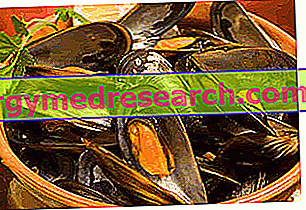What are
Mussels ( or mussels ) are bivalve molluscs belonging to the Order of Mytiloidae and to the family Mytilidae ; the term "mussels" refers exclusively to the genus Mytilus, which however includes two quite similar species: the galloprovincialis (native of the Mediterranean sea and very present in Italy) and the edulis (typical of the Atlantic ocean).

Mussels are creatures widely distributed throughout the Italian peninsula, with greater presence (both in the wild and in the water-culture) near the Adriatic coast; They are NOT fish but they are in any case part of the group of fishery products and - also thanks to the moderate cost - their consumption represents one of the main sources of livelihood of the Italian fish trade.
Description and Biology
The mollusk of the mussels is duly protected by two oval, elongated, triangular and curved shells near the apex; the margin of the shells has a fairly pronounced protuberance.
Externally, the mussels are black tending to dark purple and with brown reflexes and have thin circles of growth (although the coloring, like other morphological aspects, varies from area to area). The inner face of the mussels is bluish and bright, more or less mother-pearly (especially in the Moscioli, a variety caught in the Portonovo area of Ancona, in front of Mount Conero). The two mussel shells are held together by a serrated hinge at the thinner end. The color of the mollusc varies from almost red orange (in sexually mature females) to yellow (in sexually mature males) with the edges of the gill lamellae of an intense black and light and brown shades on the digestive organs.
The gill lamellae of mussels are essential for retaining oxygen and picking up food. Unlike clams or scallops, mussels DO NOT stay in the sand and are NOT equipped with propulsion organs or appendages for movement in the fluid or bottom; the mussels are fixed and well bound to structures of various kinds by means of a weave of very resistant fibers (the fine linen - to be eliminated by cleaning the animal before cooking).
The mussels easily reach 10cm in length and 4 in width, they live for some years and reproduce incessantly by secreting eggs and sperm in free water which, after fertilization, develop into larvae and take root by means of the byssus.
Distribution
Mussels are NOT hard to find foods; the coasts of the Adriatic Sea are almost haunted, as are some areas of the Ionian Sea and a few others of the Tyrrhenian Sea. Mussels feed on both organic particles in suspension and plankton, both of which are very present in the brackish waters of the mouths; it is not by chance that the Adriatic Sea (a coastline that starts in Friuli Venezia Giulia and ends in Puglia - the richest sea side of the river) is almost a single uninterrupted colony of wild mussels; but the fact remains that this species can be successfully cultivated (in water-crops, both in the pockets of the valleys and on the high seas) in all areas of the Mediterranean sea.
Flavor
What does the taste of mussels depend on?
The mussels have meat with an intense and decisive taste but the relative organoleptic and nutritional characteristics are subject to some intra and interindividual variations; this is justifiable by several factors such as:
- Mussel catching / picking season: they grow and reproduce effectively in spring and summer, when they are more pleasant to taste; in parallel, a chemical analysis often shows a higher cholesterol content
- Size of the mussels: the age of the mollusc determines the consistency and taste that, in the adult and "elderly" creature (up to and beyond 4 years of life - ≥3-4cm in length) can be excessive and unpleasant
- Place of collection / cultivation of mussels: the mussels feed differently between the open sea and the areas near the river mouths; obviously, this determines a remarkable variability of the organoleptic and gustatory characteristics of the food. Furthermore, on the mouths the mussels grow much more quickly due to the very high content of organic residues which, directly (since the mussels feed on them) and indirectly (because they feed the plankton which represents an additional source of nourishment for the mussel) feed the molluscs. Unfortunately, the same molecules also promote bacterial proliferation (already high due to discharges upstream of river courses) which, like pollutants ( Polychlorobiphenyls - PCBs, mercury, lead, etc.) and the presence of some viruses, compromise food safety of mussels. On a practical level, this aspect suggests to abolish the collection of wild mussels (since they are not guaranteed at biological and veterinary level) and to favor the procurement through the purchase in good standing.
Hygienic aspects
From the above, it can be deduced that wild mussels constitute a potentially contaminated food and responsible for various food diseases. Among these, in addition to the poisoning / accumulation of PCBs and metal powders (against which it is not possible to intervene), viral and bacterial contents are worthy of attention. As far as viruses (especially type A, which gives rise to hepatitis) are concerned, it is possible to intervene on the food, guaranteeing its wholesomeness by cooking at temperatures that are not too high; on the contrary, wanting to eliminate some bacteria such as cholera vibrio, some coliforms, salmonella etc., it is necessary to reach higher temperatures and carry out a complete and deep cooking of the molluscs.
Purchase Tips
Upon purchase, the packs (retinas) of the mussels must make use of a complete and exhaustive food label, therefore equipped with both traceability and health certification (European legislation). Fresh mussels are well closed and heavy (as they are still full of water), and beating them on a solid surface produce a dull noise and NEVER "emptiness"; the live mussels still have the bisso (tuft) without which they die in a very short time. It is possible to preserve the mussels after refrigeration over a period of time ranging between 24 and 48 hours, or up to a few more days if stored in vacuum trays
Recipes and Preparation
From the culinary point of view, the mussels do NOT need "purging" (although, if they are taken during a storm, they too could contain a certain amount of sand); before cooking, it is instead necessary:
- Clean the shells externally by removing algae and "dog teeth"
- Remove the byssus (unpleasant to the touch and taste)
From the gastronomic point of view, the mussels "should" not undergo long cooking and the suitable time for preparation would be that necessary to open the two valves; however, as anticipated, it is always essential to guarantee food healthiness by prolonging the heat treatment just enough to reach temperatures "at the heart" of the food that are around 100 ° C. To this end, it is advisable to use a lid to be placed on the pan in cooking to help achieve the highest temperature in the shortest possible time; in this way the softness of the mollusc is better preserved, which if subjected to excessive cooking would tend to dehydrate acquiring "gumminess".
digestibility
Mussels are not very digestible foods but, contrary to popular belief, they are not particularly demanding in gastric transit.
| Nutritional composition of Mussels - Reference values of the INRAN Food Composition Tables | ||||||||||||||||||||||||||||||||||||||||||||||||||||||||||||||||||||||||
 | ||||||||||||||||||||||||||||||||||||||||||||||||||||||||||||||||||||||||
Nutritional values (per 100 g of edible portion) | ||||||||||||||||||||||||||||||||||||||||||||||||||||||||||||||||||||||||
| ||||||||||||||||||||||||||||||||||||||||||||||||||||||||||||||||||||||||
The legend according to which the mussels are "heavy" is the result of the conceptual distortion that involves two very distinct aspects of the food: the first concerns the presence of strong aromatic components of fresh raw garlic (perceptible in digestive eructations) as an ESSENTIAL ingredient in preparation of the classic "tarantina mussels"; the second is due to the bad habit of consuming the CRUDE mussels in large quantities, like a snack.
In the latter case, in addition to suffering the reduced digestibility of RAW food (also rich in salt), it is possible for diners to encounter real food-borne illnesses due to the considerable bacterial loads present in the mussels (which manifest themselves with nausea, vomiting and diarrhea). Raw mussels, an essential delicacy for "genre" lovers, are not considered SAFE foods.
Nutritional characteristics
Mussels are fishery products of animal origin and, as such, have a good content of high biological value proteins. On the other hand, they also possess a high cholesterol content which, with respect to what is mentioned in the general description of the bivalve, may vary according to the time of year (the animal's reproductive cycle favors its increase in meat). The intake of fatty acids is moderate and the lipid profile is positive because it is equally divided between saturated, monounsaturated and polyunsaturated fats; there are also moderate concentrations of carbohydrates, consisting mainly of the animal's glycogen. Mussels boast a decidedly low energy intake.
There is no lack of mineral salts, one of which is present in excessive quantities: sodium. This macro-element makes the mussels (especially prepared "in stew" - a process that preserves the water content of the clam still closed) a product to be consumed in moderation, particularly in patients with metabolic alterations such as pre-hypertension or overt hypertension. Potassium and phosphorus are not lacking, but what characterizes the meat of mussels is above all the high supply of bio-available iron.
From a vitamin point of view, mussels contain good amounts of thiamine (vit. B1) and niacin (vit. PP), but moderate concentrations of vit are also highlighted. TO.
Cleaning and Cooking
Feel like molluscs but not familiar with the operations of choice and cleaning? No fear! In this video recipe our personal cooker Alice shows you how to select and clean mussels, and then prepare a delicious mussel with tomato sauce.
How to Cook Mussels - Mussels Impepata with Cherry Tomatoes
X Problems with video playback? Reload from YouTube Go to Video Page Go to Video Recipes Section Watch the video on youtube



